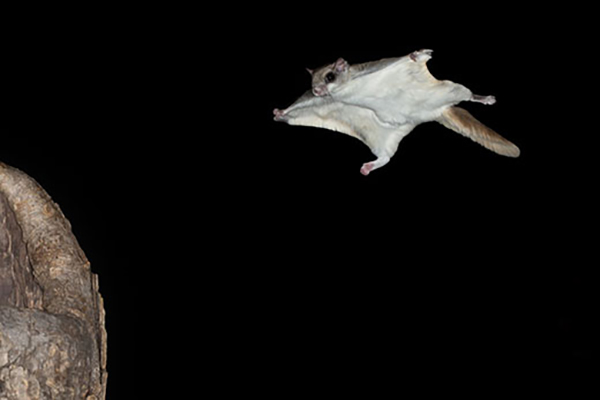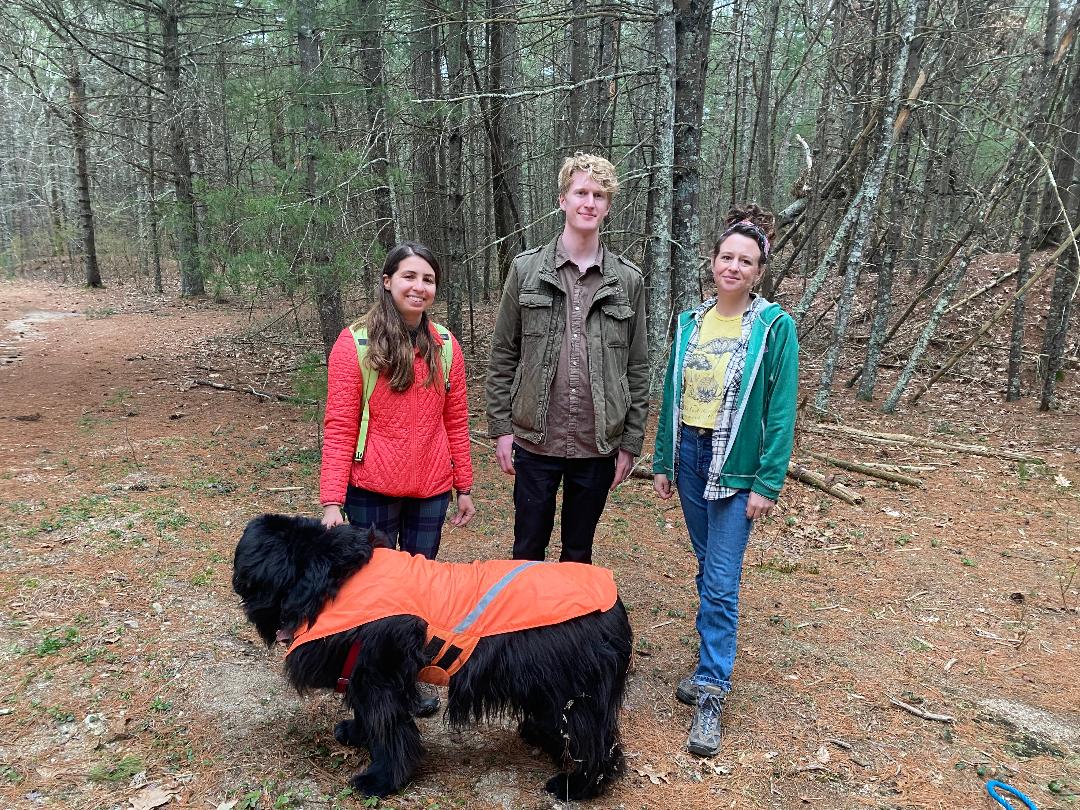The Secret is Out: Some Local Squirrels Can Fly
January 5, 2024
LITTLE COMPTON, R.I. — A rare habitat that only grows in the right conditions in southern New England is the perfect home for a secret squirrel. No, not the trench-coat/hat-as-a-mask-wearing Agent 000 who hung around with a mole called Morocco. This squirrel can fly, kind of. No, not the aviator-hat-wearing rodent from Frostbite Falls, Minn., who shared adventures with a moose named Bullwinkle.
Unlike its cartoon brethren, however, the southern flying squirrel is real. The little mammal glides from tree to tree using a special membrane between its front and back legs. Flying squirrels are nocturnal, but you may be lucky enough to see one glide overhead if you take a walk in the Simmons Mill Pond Management Area around dusk.
“If you’re not out at night, you wouldn’t be seeing them,” Roger Greene told ecoRI News last year.
He should know. Roger and his wife, Gail, have lived in the stone farmhouse next door to the management area off Coldbrook Road for decades. Their stewardship of the land, which has been owned by the state since 1995, is legendary and generous. (To read a story about the couple’s tireless work, click here.)

Roger and Gail place nest boxes around the management area for wildlife to make their homes, and for flying squirrels it is suggested to hang them between 10 and 25 feet off the ground. Since the squirrels glide rather than fly, they need some height to get from tree to tree.
The couple’s research on the hard-to-observe forest creature found flying squirrels often nest in dead beech trees and red oaks, which are abundant in the Simmons Mill Pond Management Area. They also make their homes in woodpecker holes, abandoned nests of birds and other squirrels, and attics.
“It’s an interesting critter and nobody sees it,” Roger said.
The Greenes, however, have been lucky enough to see a few, especially one they “totally by accident and during the day” came across. They were walking in the woods one winter not too long ago and they happened to knock against a hollow tree, and a flying squirrel popped its head out at them.
“Every time we walked by that tree that winter, we’d tap it and its head popped out,” Roger said.
For the rest of us, these squirrels are out there, according to retired Rhode Island Department of Environmental Management wildlife biologist Charlie Brown.
“Southern flying squirrel is a species that is native to Rhode Island and it’s pretty much native throughout much of the eastern United States. I would consider them fairly common,” Brown told ecoRI News last year. “But, you know, they’re cryptic, so people are often unaware that they’re here because you don’t see them. You don’t encounter them like you would your typical gray squirrel … your daytime active squirrels. But they’re probably as common if not more common than gray squirrels in some areas.”
One of those places is likely the Simmons Mill Pond Management Area. This coastal maritime oak-holly forest under the Greenes’ care is well-suited for these somewhat unusual, if common, mammals.
The southern flying squirrel — also known, unfortunately, as the assapan — is one of two species of flying squirrel found in North America. The other is the northern flying squirrel. They are both gray-brown, but southern flying squirrel belly fur is all white while its northern counterpart has belly fur that is gray at the base.
The white-bellied version is found in deciduous and mixed woods in the eastern half of North America, from southeastern Canada to Florida.
Flying squirrels are the smallest species of squirrel in Rhode Island. They measure up to 8-10 inches, and can glide up to 150 feet while using their tails as a rudder. Northern flying squirrels are slightly bigger, 10-12 inches long.
Flying squirrels are omnivores, as they eat a variety of foods, including seeds, nuts, fruit, fungi, and insects. Southern flying squirrels are considered one of the most carnivorous squirrels because they supplement their diet with eggs, birds, and carrion.
Southern flying squirrels mate twice a year. When their young are born, they rely on their mothers to care for them for two months. Flying squirrels can live up to five years.
Both species are preyed upon by raccoons, owls, and hawks.
Besides the southern flying squirrel, Rhode Island, according to DEM, is home to four other related species — eastern gray squirrel, red squirrel, eastern chipmunk, and woodchucks.
Brown has encountered flying squirrels — the northern version with the white-gray belly fur can also be found in the Northeast — in Warwick and on Providence’s East Side. He also came across them conducting small mammal surveys, finding them in pitfall and cage traps.
If there are big trees with lots of cavities, then flying squirrels are likely around, Brown said.
Note: For those of you unfamiliar with Secret Squirrel and Rocky J. Squirrel, links have been provided.




I have never seen a flying squirrel, but when I lived in Maine, twice in 15 years my cat left me a flying squirrel tail. (I needed the cat because otherwise the house was overrun with mice)
Here is a story about a rare animal in this area that obviously has found a home in our area.
In another article people want to blow the top off of a mountain which is part of a browns-field site for a stone quarry. Who knows what Dow Chemical buried on this site.
No one seems to be concerned about the BaldEagles that make the mountain home.
There was a dead one in my yard in Charlestown last spring. I’ve never seen one before.